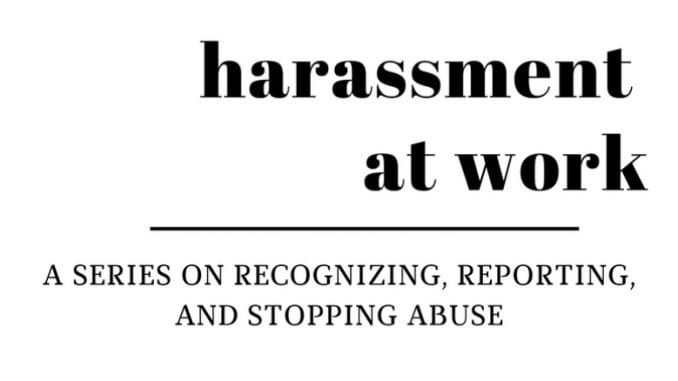
Harassment at work is real, but what do you do when it happens to you? How do you know when someone’s behavior has crossed the line? And who do you tell? In this eight-part series, we break down what harassment is and what to do about it.
BY ASHLEY RODRIGUEZ
BARISTA MAGAZINE ONLINE
Note: This series explores issues of harassment and recounts episodes of alleged harassment in the workplace. If you are sensitive to stories and scenarios depicting workplace harassment, please be advised.
This series is an accompaniment to the February + March 2018 article, “Coexisting at Work: Sexual Harassment Policies,” written by Lauren Lathrop. It’s meant to define sexual harassment and provide a blueprint as to how to handle workplace harassment. The first part of this series defined harassment, part two talked about legal protections and laws defining sexual harassment, part three discussed the various forms of documenting harassment, part four explored evidence, and part five highlighted the role of bystanders. In part six, we talk to an employment lawyer about filing harassment claims and common mistakes.
It can be difficult to discern if you are the victim of workplace harassment. For many victims, doubt, fear, and uncertainly can make one second-guess their suspicions. That’s why it’s so important to understand harassment thoroughly, including how to file harassment claims. To help us better understand the topic, we were lucky enough to chat with David C. Martin, a trial attorney at MBE Law Group in Seattle who specializes in breach of contract, partnership/LLC member disputes, fraud, employment discrimination, sexual harassment, and wrongful termination suits. He has also helped with the #coffeetoo project, and generously walked us through tons of legal jargon to explain some common misconceptions about harassment claims, what to do when you think you’ve been harassed, and the importance of paper trails.
What are the responsibilities of an employer when a harassment claim is brought up? Are employers required to fire an employee who has been accused of harassment?
The employer’s duty is to take prompt and effective action to end the harassment. If the employer does nothing or the employer’s attempted remedy is ineffective, then the employer becomes liable. The employer is not required to terminate the individual accused of harassment, but terminating the offending employee is obviously a very effective way to end the harassment. The employer can choose other methods short of termination, such as disciplining the offending employee, transferring the offending employee, and coaching or training the offending employee. Whatever method is chosen, the employer’s obligation is to put an end to the harassment.
In many instances, an employer investigates the complaint and concludes that no harassment occurred and therefore no remedial action is necessary. This works fine if the employer is actually correct in its conclusion. But if the employer turns out to be wrong, then it risks being liable for failing to take action. A responsible employer will engage in a serious and genuine investigation. Unfortunately, there are still plenty of employers who engage in investigations intended to discredit the accuser and protect the harasser. This is particularly true when the harasser plays an important role in the company.
What counts as proof in a harassment claim? Why is it important to always have a paper trail?
In court, the employee has the burden of proving the elements of workplace harassment by a preponderance of the evidence, which means proving that it is more probably true than not. A jury or judge will be deciding the case based on the testimony of the witnesses and any exhibits that are admitted into evidence. In many cases, there is no paper trail showing the harassment, so the jury or judge will base its decision upon whether the victim’s testimony is credible and whether anyone else witnessed the harassment. Of course, it’s far easier to prove harassment if there is some documentation corroborating that it occurred. This means that’s it’s crucial to save any text messages, emails, or other communications evidencing the harassment.
It’s also important to retain any evidence showing that you complained of the harassment, whether it was to a coworker, directly to the harasser, to your managers, or to human resources. When employees only complain orally to their managers or human resources, then there is a risk that the company will deny ever receiving the complaints or will mischaracterize and minimize the nature of the complaints. For this reason, it’s important for employees to have written documentation of those complaints. If the complaint first arises during an in-person meeting, then the employee can follow up by sending an email confirming that they made an oral complaint during that meeting. It’s also wise for employees keep their own copy of any complaints, and to keep that copy in a place where the employee won’t lose access to it if they are suddenly terminated.
What are common misunderstandings about harassment claims?
Many people don’t understand that phrases like “hostile work environment” and “harassment” have legal meanings that are different than how these terms are sometimes used in the media or in everyday conversation. State and federal laws prohibit harassment based on certain legally protected characteristics, such as sex, race, national origin, religion, disability, etc. To have a legal claim for hostile work environment or harassment under these laws, it’s not enough that the work environment is hostile. The harassment must be motivated by one of these protected characteristics.
What should someone do if they think they are the victim of workplace harassment?
The employee can complain to the appropriate manager or human resources representative in the company. If the employee believes they are being harassed or subjected to a hostile work environment, then the complaint should clearly allege that. When an employee instead makes a vague complaint about bullying or unfair treatment, this does not trigger the same legal obligations on the employer’s part as complaints of harassment based on protected characteristics like sex or race. Furthermore, complaints that aren’t connected to a legally protected characteristic, like sex or race, are not subject to the same legal protections against retaliation by the employer. The employee should also consider contacting an attorney who practices in the area of employment law. Many attorneys in this practice area will provide a free initial consultation.
Are harassment claims different when they involve a coworker versus a manager or someone above you? Are the standards for proving harassment different?
If the harasser is not the victim’s supervisor, an employer’s liability is based on the employer’s negligence, meaning the employer isn’t liable unless its management knew or should have known of the harassment and failed to take prompt and effective action to end the harassment. If the harasser is the victim’s supervisor, then the employer can be liable even if the employer wasn’t negligent and its management didn’t know about the harassment. There are defenses that an employer can raise to supervisor harassment, but generally speaking, an employer is significantly more likely to be found liable for supervisor harassment than coworker harassment.
What are some of the difficulties of proving harassment in coffee shops?
Many of the laws prohibiting harassment only apply to employers of a certain size. For example, Title VII of the Civil Rights Act only applies to employers with 15 or more employees. Small coffee shops might not meet this threshold. However, if the coffee shop is too small to be subject to federal laws governing harassment, individual states often have harassment laws that apply to smaller employers, so it’s still possible that there is a legal remedy. If you work in a small coffee shop that isn’t part of a larger company, it’s also more likely that the employer doesn’t have a human resources representative and doesn’t have clear policies regarding who an employee should complain to if experiencing harassment.
What are some of the difficulties of proving a harassment claim?
The biggest difficulty in proving harassment claims is that there typically isn’t smoking gun evidence like an email or text message that clearly shows the harassment. Another difficulty is that witnesses sometimes are fearful of retaliation and losing their jobs, so they aren’t willing to assist the victim and provide truthful testimony, or the witnesses won’t provide assistance because they are friends with the accused harasser, or the witnesses simply don’t want to be involved in an investigation or lawsuit.
What would you like people to know about harassment? As a lawyer, what information do you think would be most helpful to victims?
Just because you don’t have smoking gun evidence corroborating the harassment doesn’t mean that you shouldn’t complain about it. Although it’s hard to prove harassment in a court of law, many employers will take the complaint seriously and try to remedy the situation. Unfortunately, some employers won’t take it seriously or will illegally retaliate against the employee. When that occurs, it is sometimes easier to prove the retaliation than the harassment, and it’s not uncommon for an employee to prevail in court on a claim of retaliation even though the employee was unable to prove the underlying harassment.
I’d also encourage anyone who is experiencing harassment to contact an attorney. Many attorneys won’t charge you anything for the initial consultation, and many attorneys in this practice area offer representation on a contingent fee basis rather than charging clients on an hourly basis. I’d particularly encourage victims of harassment to promptly contact an attorney if terminated and offered a severance agreement, because those agreements will almost always include a release of all claims relating to harassment.
Disclaimer: This article is meant to be informative and provide guidance. This is not meant to be legal advice. This publication is read by a variety of people all over the world, and laws regarding workplace harassment can vary wildly. If you are thinking about filing a workplace harassment lawsuit, please consult a licensed attorney in your state or jurisdiction.

